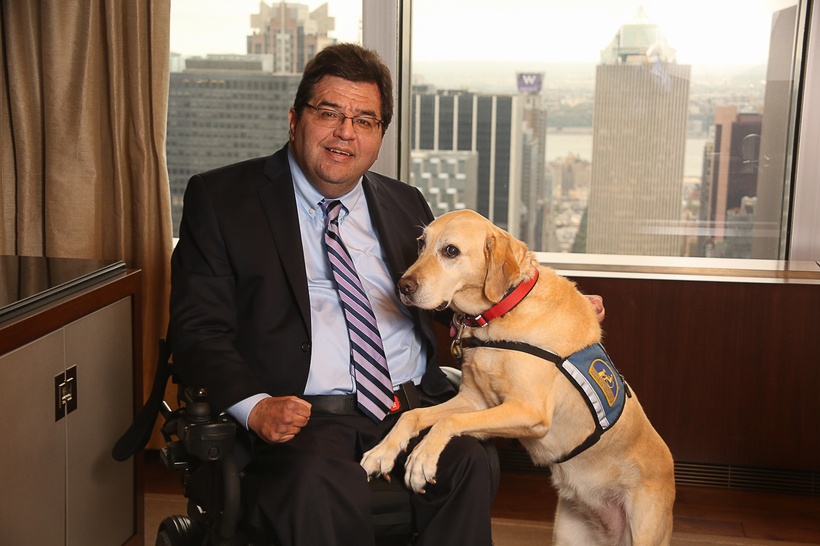 In matters of disability, diversity, and inclusion there’s no one better qualified to address and conquer obstacles than Jim Sinocchi. He’s the ambitious and accomplished Head of Disability Inclusion at JPMorgan Chase & Co., who’s also a C5-C6 quadriplegic. And his solution-oriented, no-beating-around-the-bush or pulling-any-punches approach makes him the perfect champion for working people with disabilities.
In matters of disability, diversity, and inclusion there’s no one better qualified to address and conquer obstacles than Jim Sinocchi. He’s the ambitious and accomplished Head of Disability Inclusion at JPMorgan Chase & Co., who’s also a C5-C6 quadriplegic. And his solution-oriented, no-beating-around-the-bush or pulling-any-punches approach makes him the perfect champion for working people with disabilities.
“There are qualified people with disabilities working right now – contributing to the bottom line,” declares Sinocchi. “People with disabilities are in the workforce with the right qualifications and competing for the same jobs that able-bodied people are doing. We shouldn’t be just a diversity metric. We have the skills to build professional careers and want to be part of a thriving business.”
When it comes to leveling the competitive field, maximizing performance, and supporting success, Sinocchi says, “People with disabilities don’t want to be a burden.
If we can make the environment accessible, it’ll allow us to work as independently as we can, dispelling a myth that employees with disabilities always need assistance. This is no longer the era of ramps, wheelchairs, and minimum-wage jobs. This is the era of full assimilation into the corporate culture. It’s about proactive leadership, building careers, earning a living and partnering with leadership and colleagues as they manage their personal career trajectory.”
“The firm has been focused on disability inclusion since 1924” shares Sinocchi. “The last century in Corporate America was about giving work to qualified, diverse people, but people with disabilities were historically underrepresented and left out of the conversation.”
This, he says, is in part because what worked for hiring and assimilating other groups (black, Hispanic, women, LGBT etc.), doesn’t work for the disabilities group. Sinocchi isn’t afraid to voice the hard issues, saying, “Why are we afraid of this group of people? Why are people with disabilities traditionally looked at with discomfort? It’s human nature to have a visceral reaction to differences. But when you call a person in for a job, you call them because of their resume of abilities. Why then do we get nervous when we see that they have a disability? It doesn’t change their already-acquired skills and abilities.”
As a roadmap to help people create a dynamic, inclusive environment, Sinocchi advises them to examine the “4 A’s”: Attitude, Accommodations, Accessibility, and Assimilation.
“These are not technical or invented. They’re already in our vocabulary and represent exactly what we know them to mean. How do you feel about people who are different than you? How do you engage them? How do you get employees the accommodations they need to perform their job? You can’t have people with disabilities going around asking for help from others to do their job because the environment isn’t accessible. Do employees have the opportunity to assimilate into the company? Do they believe they have a shot at advancing their career from the mailroom to the boardroom?”
To open the doors of communication further and demystify disabilities, Sinocchi and JPMorgan Chase started “Disability Dialogues” – video interviews of executives asking people with disabilities questions about their life. “Questions everyone wants to ask, but were afraid to because they didn’t want to offend anyone,” says Sinocchi. “The videos are shown across company, all over the world. We’re getting real with this population, changing perspectives. It’s a different dialogue.” The firm has implemented other significant mechanisms to make inclusion more seamless, including an Accommodations Fund, which is a program that enhances the reasonable accommodations process already in place to help requests get completed as quickly as possible. This frees managers from worrying about the cost of accommodating an employee, and empowers them to hire people with disabilities. The company also maximizes technology to provide accessibility worldwide.
“I’ve been able to experience firsthand, how JPMorgan Chase supports inclusion through actions, not just words. It’s in their DNA and they just keep advancing the culture. Right now, major initiatives (in addition to Disability Inclusion) include the military and veterans hiring effort, Advancing Black Leaders, and one of the best LGBT equality initiatives around. This is important because if we’re inclusive inside, we’ll be inclusive outside with our customers.”
“I tear-up a lot in this job because I get to see great moments of humanity in my role.
I met a woman a while ago, who’s legally blind. She acquired the blindness while working on the job, diagnosed with an eye disease that took away most of her vision. She was on track to become a Vice President, but she didn’t feel she could get there because of her diagnosis. JPMorgan Chase worked with her to get the accommodations she needed to keep doing her job, moving her to a new position where she could be successful, and she did. She’s intelligent, efficient, and terrific at her job. Last January, she sent me an email saying she just got promoted to VP! This is what JPMorgan Chase is about.”
Sinocchi had this to say about starting a career at JPMorgan Chase. “We don’t have jobs for people with disabilities; we have jobs for people who are qualified to work here, including people with disabilities. If you want to work at JPMorgan Chase, own your disability, and demonstrate that you’re qualified. We’re hiring for what you can do for our company and our customers. It’s not charity. When we hire a person with a disability, we want them to succeed and advance. ”
